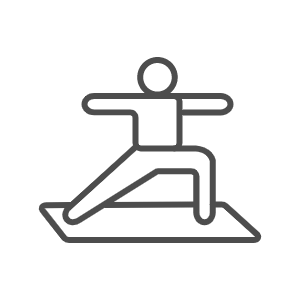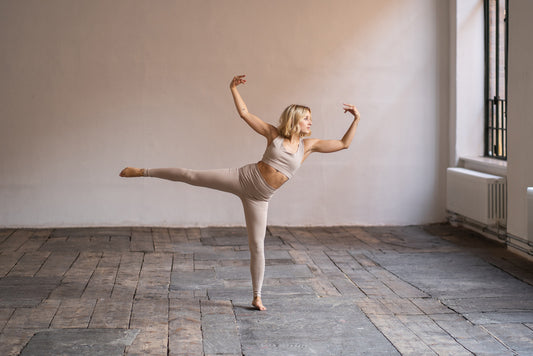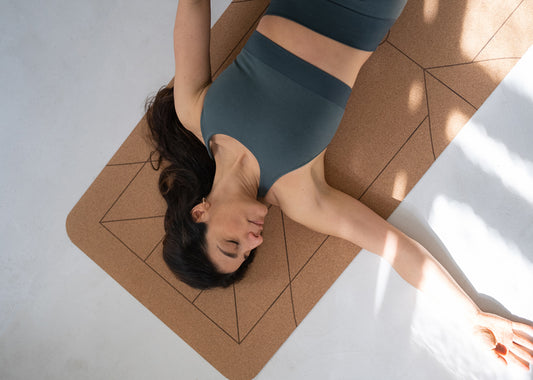
NEW In!
PURE-Matte Light TaupeShopping cart
Your shopping basket is empty
Yoga

Meditation
Sets & Bundles
“Reducing obstacles in the mind and blockages in the body results in our physical functions being in harmonious balance.”
Yoga Sutra 2.43
 ... not only our body comes into a harmonious balance, our inner world does the same. Negative thoughts, blocking beliefs and feelings that we carry around with us for a long time without processing often become a heavy burden for body and soul. Working through and resolving emotional blockages and traumatic experiences is the goal of psychology and all psychotherapeutic concepts, but also of many old spiritual traditions, including yoga.
... not only our body comes into a harmonious balance, our inner world does the same. Negative thoughts, blocking beliefs and feelings that we carry around with us for a long time without processing often become a heavy burden for body and soul. Working through and resolving emotional blockages and traumatic experiences is the goal of psychology and all psychotherapeutic concepts, but also of many old spiritual traditions, including yoga.
Before we continue in the blog post, we would like to point out that the exercises and tips described do not replace therapy in any form or promise a type of healing. A yoga practice can accompany professional therapy. If you have not had any experience with yoga yet, we recommend that you attend a few yoga sessions in advance.
In order to understand how a regular yoga or meditation practice can support you in the process of working through emotional blockages, we first need to understand what exactly an emotional blockage is and how it can arise. You will then be introduced to 3 yogic practices that can support you in your mental health.
We humans are deeply feeling beings and from an early age we experience and feel different emotions - joy, love, fear, anger, sadness or disappointment, etc. Every inner feeling comes with a corresponding physical sensation, for example our body and nervous system are completely relaxed , when we feel love or feel loved and seen. There is a certain lightness and joyful relaxation in the body.
However, if we experience feelings of fear, nervousness or anger, we are not only tense internally - the internal tension also manifests itself externally through tensing muscles and shallow breathing. The body reacts to internal turbulence with a stress reaction and we feel stiffness or tightness.
What happens to the body and mind when we get stuck in such a stress response as a result of traumatic experiences or unprocessed feelings? What happens if, for example, we experienced intense feelings of fear, sadness or pain in childhood and had no opportunity to process these experiences and feelings and release them from our physical and emotional bodies? The body, the nervous system and the subconscious store these experiences and look for ways to integrate what they have experienced and develop protective mechanisms.
Maybe it's difficult to trust other people, open up and build closeness, or you have seemingly unfounded fears and worries, don't feel at home in your own body, feel (performance) pressure and find it difficult to really find peace - that Letting go is difficult.
Emotional blockages can also manifest themselves in this way:
• Lack of body awareness
• Overwhelm
• Depressive or anxious moods
• a constant “tension”
• Distrust and uncertainty
• Sleep disorders
• Nervousness and restlessness
• Shoulder and neck tension
• Tension in the jaw
• Headache or migraine
• shallow breathing
• Cardiovascular disorders
• Gastrointestinal problems
• et al
“The body is the temple of your soul”
BKS IYengar
The goal of yoga is to bring body, mind and soul into harmony and to create a harmonious balance between these levels. Hatha yoga in particular is a body-oriented practice that trains you to be mindful of your own body.
Our emotional tensions and traumas are often intertwined with physical tensions and pain. During yoga practice we begin to release muscular tension and this process can also release the associated emotions tied to our muscles. Our yoga practice strengthens our physical, mental and emotional bodies and increases our ability to process difficult feelings and past traumas. When our bodies are strengthened, our emotions feel safe and can be released and expressed.
Hatha yoga can help release emotional blockages by releasing certain tensions and energy blockages in the body. Yoga provides a healing and special space to arrive back in your own body and explore in which areas of the body we hold tension or pain.
The deep inner concentration we develop in yoga naturally leads us to become aware of forgotten or unconscious emotions. The brighter the light of our concentration and awareness shines, the more we can see into our shadowy selves.
Yoga asanas, meditation, breathing and relaxation techniques help the subconscious to let go . For this reason, it may happen that after or during a yoga session you feel the need to cry or other feelings come out. This is a very good sign that the blocked energy is starting to move again and is now given a safe space to be felt and perceived without judgment.
In such moments, let everything be and happen exactly as it is happening in the present moment. Connect with your breath and allow your body to “discharge.”
Yoga asanas:
Gentle Yin yoga sessions, heart-opening exercises and nourishing hip openers can help you bring blocked emotions in the body back into flow.
In your yoga practice, try to stretch and relax the areas of the body in which you noticeably have regular tension, for example, yoga for the back if you have shoulder and neck tension or yoga for a flexible hip if you have a rather stiff pelvis. If you want, affirm for example, "I release the burdens of the past that I still carry on my shoulders." or “I open my heart and allow healing to happen.”
Meditation for inner silence and grounding
Meditation can be a valuable anchor for inner peace and grounding, because withdrawing the senses teaches us to find our inner center in the flow of life. Especially when things are restless inside, guided meditations for grounding and basic trust can be a healing support in getting back to yourself before you dare to try advanced meditation techniques.
Accompanied meditations for the root or heart chakra, guided journeys to the inner child or to cleanse the energy body help you to regulate yourself and reflect mindfully - the main thing is that you regularly set aside time for yourself and give space to your feelings and related topics honestly and lovingly .
Deep relaxation and yoga nidra
Yoga Nidra is a technique of yoga also known as "yogi's sleep." It is a type of guided meditation in which the body is kept in a state of relaxation while the mind remains awake and alert. Through this practice we can learn to distance ourselves from our thoughts and emotions and focus on the here and now .
Scientific studies have shown that regular yoga nidra can improve mental well-being. It can help reduce stress and anxiety, improve sleep quality, and promote feelings of inner peace and balance. In addition, yoga nidra can also help improve memory and concentration.
Overall, Yoga Nidra is a simple and effective method to promote mental well-being and calm the mind. It is a wonderful way to find a moment of relaxation and peace in our hectic world.
Mental and emotional health are of course much more complex issues, but the path to a fulfilling and, above all, easier life does not always have to be rocky. Yoga and other mindfulness practices can be incredibly valuable companions in these processes and effectively support the healing path.
We hope we were able to give you a few little suggestions for your mental well-being.

Yoga lebt von einem achtsamen Körperbewusstsein, der Wahrnehmung des Atems und der Geisteskontrolle in der Meditation. Alle yogischen Praktiken hab...
Continue reading
I studied psychology because I love people, their experiences and behavior interest and fascinate. In particular, I have always been interested i...
Continue reading